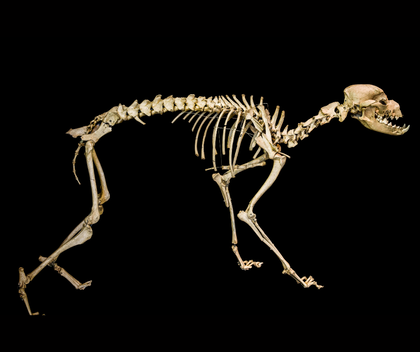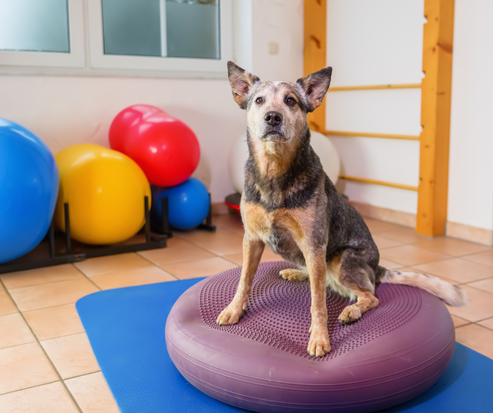|
Hey everybody! If you're interested in veterinary medicine or canine bone health, you've come to the right place. In this blog post, we'll be looking into the subject of canine bone healing and discussing some of the time frames that are relevant to it. As a canine physiotherapist, I’ve had the privilege of helping doggos (and their owners) navigate their way through fracture management and it really all comes down to some set time frames that we must be aware of when progressing through the rehabilitation process. Let's take a closer look at the subtle process of bone healing and why these time frames are important in the rehabilitation process. Understanding Canine Bone Healing: Our doggos share a strong skeletal system, comparable to ours, which is capable of recovering from fractures, breaks, and other various bone-related injuries. Following a bone injury, a complex series of events takes place in the body, aimed at repairing the damage and restoring the bone's strength. The healing process can be broadly divided into three phases, each with its unique characteristics Inflammatory 1) The inflammatory Phase: The first phase, known as the inflammatory phase, typically lasts from one to seven days. During this phase, the body responds to the injury by initiating a rapid and intense inflammatory response. The injured area becomes swollen, painful, and tender to the touch as the body's immune cells rush to the site to remove debris and start the healing process. Blood vessels dilate, increasing blood flow to the area and allowing immune cells to reach the site more quickly. 2) The reparative phase: The second phase, called the reparative phase, typically lasts from one week to several weeks. During this phase, the body begins to form a soft callus, consisting of cartilage and fibrous tissue, around the injured bone. Over time, the callus transforms into hard bone tissue, gradually restoring the bone's strength. The reparative phase is a critical stage in the healing process, and proper care and rehabilitation during this time can significantly improve the chances of a full recovery. 3) The remodelling phase: The final phase, known as the remodelling phase, can last several weeks to months, depending on the severity of the injury. During this phase, the bone remodels and reshapes itself to regain its original form and strength. This ongoing process involves the removal of old bone tissue and the formation of new bone tissue, refining the bone's structure over months. The remodelling phase is a gradual process, and it may take several months for the bone to return to its pre-injury strength. Factors Influencing Healing Time: When it comes to a dog's bone healing process, various factors can significantly impact the duration it takes for the bone to heal. Understanding these variables is important to that the doggo receives appropriate care and treatment from the veterinarian or canine therapist and also for the pet owner to understand and adhere to continued care at home. Type and location of the injury: One of the primary factors that affect the healing process is the type and location of the injury. If the fracture or injury is complex, the healing time may vary. Moreover, the location of the injury, whether in a weight-bearing bone or not, can significantly affect the healing process. The age and health of the dog: Diet, nutrition Another critical factor that can affect the healing time is the age and health of the dog. Younger dogs generally experience quicker healing due to their active metabolism and robust bone-forming capabilities. On the other hand, older dogs may require a longer time to heal due to their reduced metabolism and decreased bone density. Moreover, the overall health, nutrition, and the presence of underlying medical conditions can influence the speed of healing. A dog with a balanced diet and excellent health condition will heal faster than a malnourished or an unhealthy dog. Chosen treatment approach: Finally, the chosen treatment approach can play a pivotal role in determining the healing time. The treatment method, whether surgical intervention or conservative management, can significantly affect the healing process. The veterinarian will assess the severity of the injury and determine the most suitable treatment. For instance, surgical intervention may be necessary for complicated fractures, while conservative management may be appropriate for less severe injuries. While it's important to understand the intricate phases of bone healing, there are several proactive steps doggo owners can take to aid in recovery from a bone injury. Follow the veterinarian's recommendations: First and foremost, it's crucial to follow the veterinarian's recommendations regarding treatment, medication, and follow-up care. This will ensure that any dog is receiving the appropriate care for their specific injury or condition. Create a comfortable home environment: In addition to following veterinary advice, creating a comfortable environment at home to rest and recover is also essential. Reinforcing a safe and comfortable space, minimising stress and unnecessary movement. Maintain a balanced diet: Maintaining a balanced diet is also key to supporting bone health which is a nutritionally balanced diet rich in essential nutrients, supporting overall health and bone strength. Consult with a veterinarian or canine nutritionist to determine the best diet for the best advice in regards to diet. Rehabilitation and Physiotherapy: Collaborating with a skilled canine physiotherapist can also aid in recovery. Developing a tailored rehabilitation plan that incorporates targeted exercises can aid in muscle strengthening and joint flexibility. Physiotherapy and rehabilitation can play a crucial role in optimising recovery, so consider working with a professional to create a comprehensive plan. Brain stimulation and support:
Finally, it's important to recognise that the healing process takes time and patience is a virtue, particularly for a very active dog. Consider other ways to keep doggos engaged with treat games and love and affection. In order to promote the healing of bones, it's important to have a thorough understanding of the different factors that contribute to the bone healing process. Furthermore, having a clear understanding of the timeline of this process is crucial in facilitating bone healing. If you want to learn more tricks and tips and be involved in a community of like minded individuals, join our facebook group at : |
AuthorJoanna Whitehead Archives
June 2024
Categories
All
|



 RSS Feed
RSS Feed
